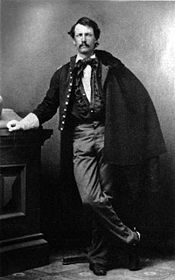
Edward W. Wynkoop
Encyclopedia

Denver, Colorado
The City and County of Denver is the capital and the most populous city of the U.S. state of Colorado. Denver is a consolidated city-county, located in the South Platte River Valley on the western edge of the High Plains just east of the Front Range of the Rocky Mountains...
. Wynkoop Street in Denver is named after him.
Wynkoop served as an officer in the First Colorado Volunteer Cavalry
1st Colorado Volunteers
The 1st Colorado Volunteers was a volunteer infantry regiment of the United States Army formed in the Colorado Territory in 1861 and active in the American West in the late 19th century.-History:...
during the American Civil War
American Civil War
The American Civil War was a civil war fought in the United States of America. In response to the election of Abraham Lincoln as President of the United States, 11 southern slave states declared their secession from the United States and formed the Confederate States of America ; the other 25...
, attaining the rank of major of volunteers, and was brevetted a lieutenant colonel in May 1865. During a period as post commander at Fort Lyon, Colorado in 1864, Wynkoop encouraged peace efforts with the Cheyenne
Cheyenne
Cheyenne are a Native American people of the Great Plains, who are of the Algonquian language family. The Cheyenne Nation is composed of two united tribes, the Só'taeo'o and the Tsétsêhéstâhese .The Cheyenne are thought to have branched off other tribes of Algonquian stock inhabiting lands...
s, but was transferred in November 1864 to Fort Riley, Kansas, where he was posted at the time of the Sand Creek massacre
Sand Creek Massacre
As conflict between Indians and white settlers and soldiers in Colorado continued, many of the Cheyenne and Arapaho, including bands under Cheyenne chiefs Black Kettle and White Antelope, were resigned to negotiate peace. The chiefs had sought to maintain peace in spite of pressures from whites...
. On behalf of the U.S. Army he investigated Col. John M. Chivington's conduct at Sand Creek, which led to Chivington's condemnation.
In 1866 Wynkoop became an Indian agent for the Southern Cheyenne
Cheyenne
Cheyenne are a Native American people of the Great Plains, who are of the Algonquian language family. The Cheyenne Nation is composed of two united tribes, the Só'taeo'o and the Tsétsêhéstâhese .The Cheyenne are thought to have branched off other tribes of Algonquian stock inhabiting lands...
s and Arapahos
Arapaho
The Arapaho are a tribe of Native Americans historically living on the eastern plains of Colorado and Wyoming. They were close allies of the Cheyenne tribe and loosely aligned with the Sioux. Arapaho is an Algonquian language closely related to Gros Ventre, whose people are seen as an early...
, resigning in December 1868 in protest of the destruction of Black Kettle
Black Kettle
Chief Black Kettle was a leader of the Southern Cheyenne after 1854, who led efforts to resist American settlement from Kansas and Colorado territories. He was a peacemaker who accepted treaties to protect his people. He survived the Third Colorado Cavalry's Sand Creek Massacre on the Cheyenne...
's village in the Battle of Washita River
Battle of Washita River
The Battle of Washita River occurred on November 27, 1868 when Lt. Col. George Armstrong Custer’s 7th U.S...
. He later became warden of the New Mexico penitentiary and died in Santa Fe on September 11, 1891.

